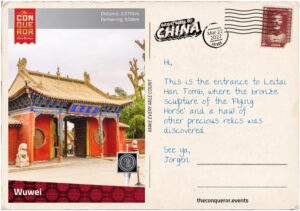Vår vandring går vidare och vi har fått vårt tjugofjärde vykort från den kinesiska muren.

Tjugofjärde vykortet.
In ancient times, Wuwei was an important town along the Hexi Corridor, a significant trading route that connected central China to the western regions. This 620mi (1000km) passage was linked by Wuwei, as its eastern terminus, to Yumen Pass, in the west. The Corridor, an arable plain, was long and narrow, sandwiched between the inhospitable plateaus of Mongolia to the north and Tibet to the south. It became a hub for the ancient silk road.
Read More